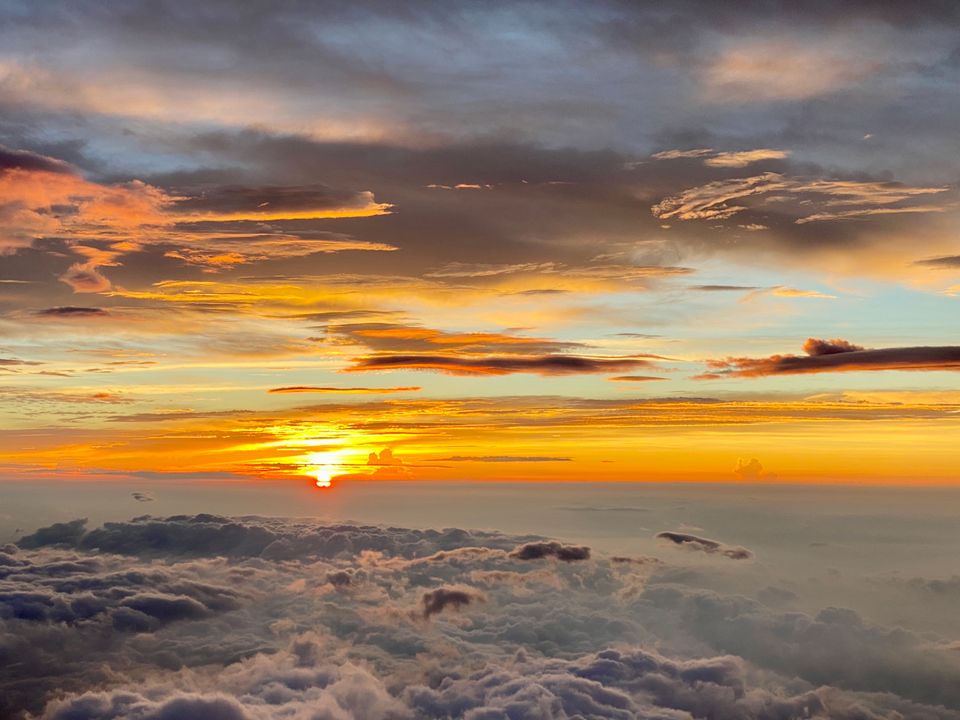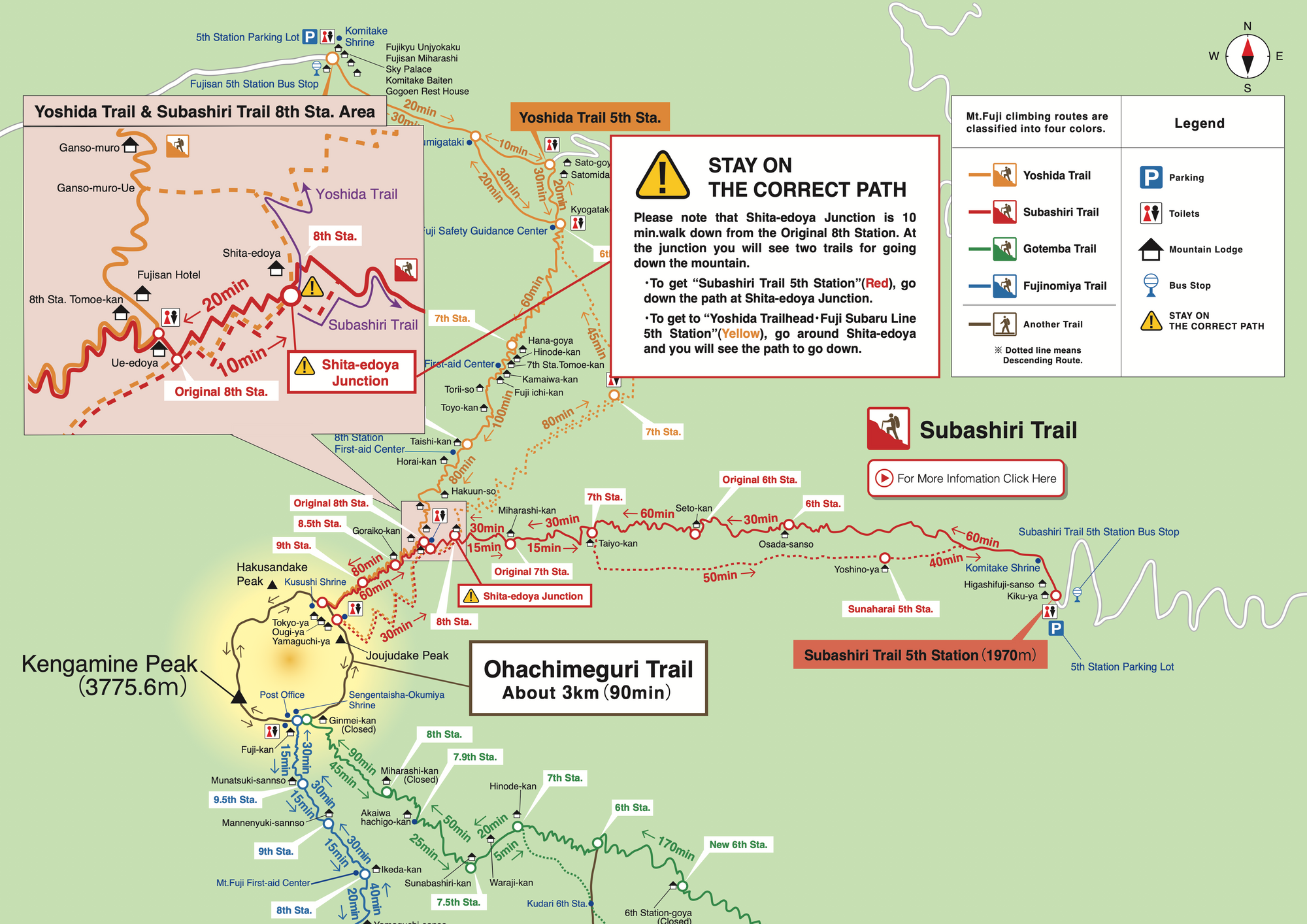I Climbed Fuji-san 🗻

After living in Japan for three long years, I finally climbed the 3,776 meters tall Fuji-san. Sitting above the clouds at the peak before sunrise and then watching the Sun come out from behind the clouds was worth enduring the arduous climb up and the freezing temperature at the summit.
Planning
After hiking a few mountains closer to Tokyo (Takao-san, Tsukuba-san, Nokogiriyama, Mitake-san, etc.), I felt bold enough to hike up Japan's tallest peak, Fuji-san. I planned for a two-day hike on Thursday and Friday (August 25th and 26th) so that I could rest on the weekend. Out of the four main trails, I picked the second most popular trail, Subashiri, to climb up and down. Since it was going to be a two-day hike, the plan was to climb about halfway up on day 1, stay in a mountain hut at night and then continue the hike on day 2. I reserved a mountain hut Miharashi-kan about two weeks in advance. The reservation included dinner and breakfast.

About ten days before the hike, I went to the Yamarent shop in Shinjuku to rent the essential hiking gear. I rented a seven-piece set that included top and bottom rainwear, a 30L backpack, ankle-high hiking shoes, trekking poles, fleece, headlamp, and gaiters. The staff at the shop don't speak English. Basic Japanese skills or preparing in advance what you want would be useful. You also need to make a reservation by phone before going to the shop. At the shop, I checked the sizes for shoes, jackets, and raincoats and then paid the rental fee. The gears were delivered to my home two days before the hiking trip. After returning from the trip, I sent the gears back from a seven-eleven close to my home.
Day 1 - Hike to the Miharashi-kan
After packing about 2.5 liters of water, a few onigiris, bread, chocolates, protein bars, and energy drinks, I headed towards the Fuji-san. After arriving at the JR Gotemba station, I had lunch as I had some time before the next bus. From the Gotemba station, I got on a bus to reach the 5th station, located at an altitude of 1,970 meters, on the Subashiri trail. The 5th station is as far as the bus goes. My journey to the summit started on foot from here. Before starting the hike, I spent about 45 minutes walking around the 5th station to get accustomed to the high altitude so that I don't get altitude sickness later. I also bought a small wooden walking stick as a souvenir. You are supposed to get it stamped/branded with a red hot iron at each station on the trail.
Fortunately, it was not sunny that day. It was cloudy, and I could see myself walking between the clouds. The weather was perfect for hiking.


The goal for day 1 was to arrive at Miharashi-kan, a mountain hut located at the original 7th station, before dark. After making a 1000 yen donation for the preservation of Fuji-san and getting a badge, I started hiking towards the 6th station, located at an altitude of 2,400 meters. This part of the trail until the 6th station was full of trees and not that steep. About midway to the 6th station, the stone path changed to gravel. The hike from the 5th to the 6th station is supposed to take 60 minutes. It took me about 90 minutes. I did make many stops on the trail to take pictures, though. Since I was excited about the hike, I was walking too fast. So, when I arrived at the 6th station, I was exhausted already. At the 6th station, I ate protein bars and drank energy drinks to recharge myself.
After taking a 15-minute break at the 6th station and getting a stamp on my walking stick, I started climbing towards the original 6th station, located at an altitude of 2,700 meters. The forest area ended at the 6th station, and the hike was under the open sky now. So I was quite thankful that it wasn't sunny that day. This part of the hike, from the 6th to the original 6th station, was supposed to take 30 minutes. But it was about 45 minutes for me.

I took a 15-minute break at this station as well and got another stamp on my walking stick, and then I was on my way towards the 7th station, located at an altitude of 3,090 meters. Hiking through these parts was quite lovely. I could see the clouds so far down. From the original 6th to the 7th station, it was supposed to take 60 minutes, and it took me the same. After arriving at the 7th station, I took another 15-minute break. The shop for getting the stamp was closed at this station.

When I left the 7th station, it was starting to get dark. I hurried towards the next stop, the original 7th station, the final stop for the day 1, located at an altitude of 3,200 meters. This part of the hike was supposed to take 30 minutes, but it took me about 45 minutes. It was already very dark when I arrived at the original 7th station. Miharashi-kan is located at this station, so after taking some pictures and getting the stamp on my stick, I headed in. Overall it took 5 hours of hiking for me to get to the original 7th station from the 5th station.


Since I arrived at the Miharashi-kan at 7 pm, which is a little late, most people staying at the hut that night had already had dinner. People staying at the hut have dinner quite early and sleep so they can wake up early the next day to continue their hike to the summit and watch the sunrise. I had curry rice and salad for dinner. I also drank some green tea. After dinner, I headed to sleep. The facilities at the mountain huts are quite minimal. I slept in bunk beds, and I was also given a sleeping bag. Lying on the bed felt quite nice after 5 hours of hiking and 5 hours of travel before hiking. I tried to sleep but couldn't due to my severe headache. Around 10 pm, it started raining heavily, so I was grateful that I had booked the hut. I fell asleep for half an hour, sometime between 10 pm and 12 am. It stopped raining around 12 am, but my headache was still going strong. At 12:30 am, I gave up on sleep and started getting ready for the next part of the hike.
Day 2 - Hike to the summit
The cold wind was blowing hard outside, so I wrapped myself in rain gear and started my hike at 1 am. I also picked the takeaway breakfast bento before leaving. My headache was so strong that I felt like giving up. But climbing up was the only thing distracting me from the headache, so I continued. Hiking in the complete fucking dark with only my headlight lighting the way did feel quite nice. On my way to the original 8th station, there was nobody else on the trail except my friend and me. At the original 8th station, I got another stamp on my stick, bought more water, ate some instant ramen, and then I was on my again. The Subashiri trail merges with the Yoshida trail here, so the trail became very crowded from here. My headache was not that strong anymore. I continued to pass the 8.5th and 9th stations but didn't stop to rest. A few minutes after passing the 9th station, the gravel path turned into a very steep stone path. This part was a little difficult but manageable.

I arrived at the summit at 3:30 am. It was supposed to take 130 minutes to climb from the Miharashi-kan to reach the summit, but it took me 150 minutes. On the summit, the temperature was around 7 degrees Celcius, but the strong chilly wind made it feel more like zero degrees. I was wearing three layers, and still, I thought I would freeze to death. There is no escape from the wind on the summit. There is no structure that can block the wind and protect you, so bring more clothes than you think you might need. I also wanted to watch the sunrise without my view getting blocked by other people. So, I had to sit on a bench in the front of the viewpoint in the cold wind to hold my seat. The sunrise was around 5:10 am, and I could see the Sun come out completely by 5:30 am. The cold wind was bothering me too much, so instead of doing any more exploration at the summit, I fucked right off to get down. What I didn't know was another tragedy awaited me.




Day 2 - Going back down from the summit
The path for going down is different from the one for going up, even for the same trail. I followed the downward path for the Subashiri trail. The path for going down was full of soft gravel and some stones. As soon as I would put a step down, it would sink to the depths of hell. If not careful, falling down and breaking a few bones was very easy. Worse, all those gravel would get in the shoes and had to be taken out every 100 meters or so. Thankfully I had gaiters, so I didn't suffer from gravel getting into my shoes. But climbing down was still hell. I found coming down much more difficult than going up, and by the time I was about halfway down, I was completely exhausted with no will left to walk anymore in those fucking gravel. As far as my eyes could see, there was only the gravel path with no end in sight. By the time I arrived back at the 5th station, there was nothing more I hated than those gravel.


Overall it took me about 5 hours to come down from the summit to the 5th station. At the 5th station, I had a celebratory beer, Rising Sun Pale Ale from Baird Beer, one of my favorite craft beers. Afterward, I took the bus back to JR Gotemba station and then took trains to return home.
Conclusion
It took me seven and a half hours to climb up from the 5th station to the summit and five hours to come back down. Climbing Fuji-san is off the checklist, but I don't want to do it ever again due to the horrible time I had while coming down. Maybe other trails are different, but I have no intention of finding out. If I could just climb up only, I'd do it times and times again. If you are thinking of climbing Fuji-san, here are my suggestions:
- Get ankle-high hiking shoes and gaiters. They are going to be completely worth it.
- Bring more food and water than you think you'll need. Prioritize more food over water because you can buy water, although expensive, at different stations on the trail, but good food is hard to come by.
- Buy water way before you run out. Some stations will be closed, and there was no open shop after the original 8th station until the summit. Also, there are almost no shops on the path to go down.
- Bring one or two extra layers to combat the strong winds on the summit.
After reading all of this, if you are wondering whether you should climb Fuji-san or not, I'd say yes, go for it. The view of the rising Sun from the summit alone makes everything worth it.
